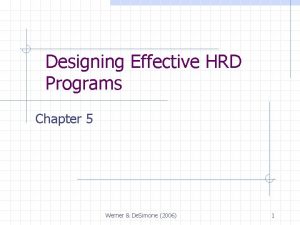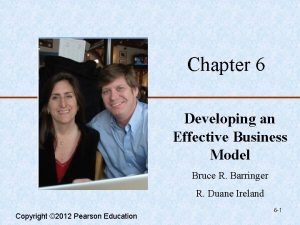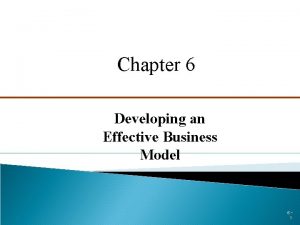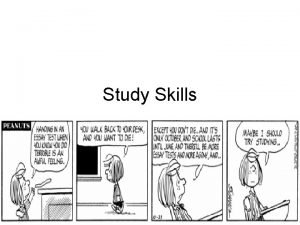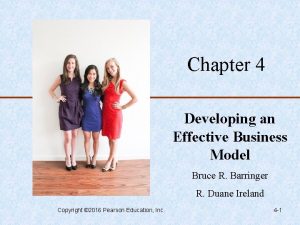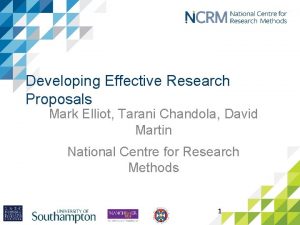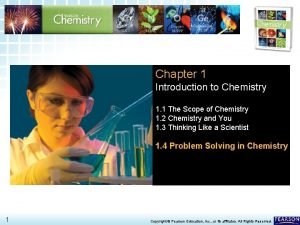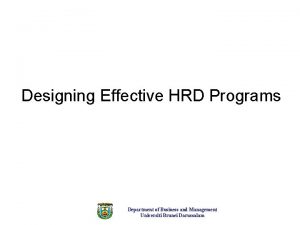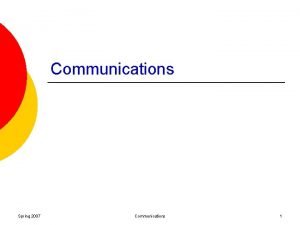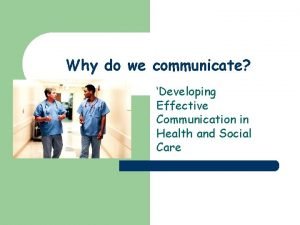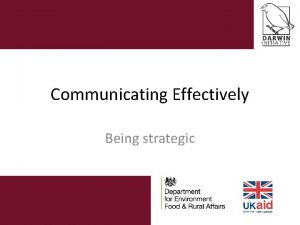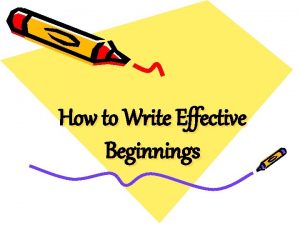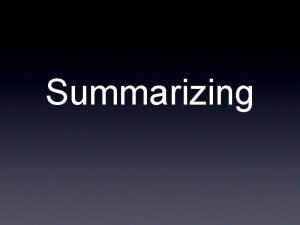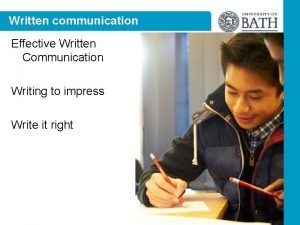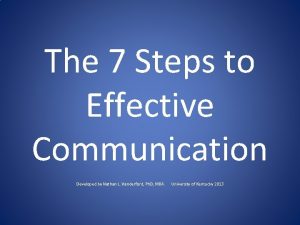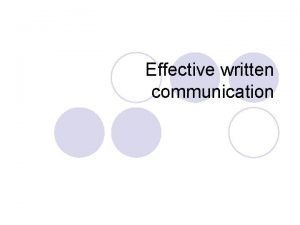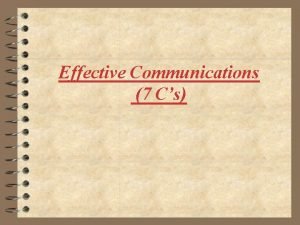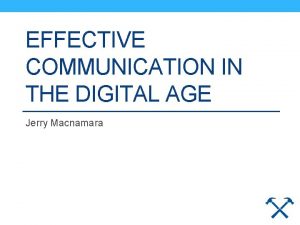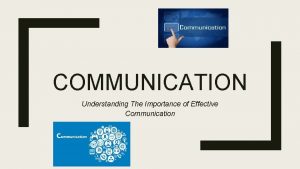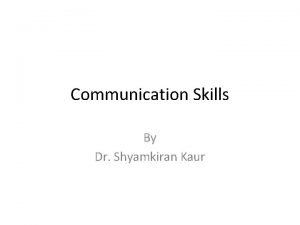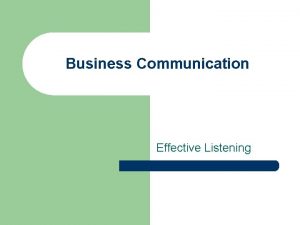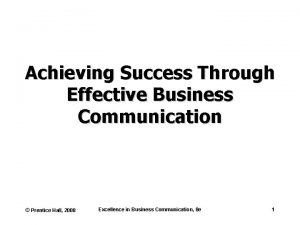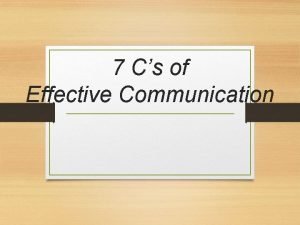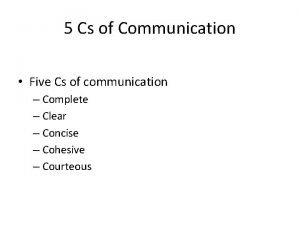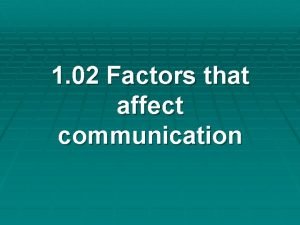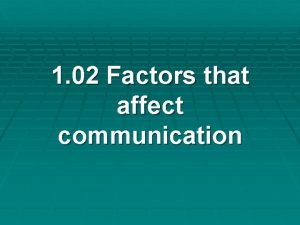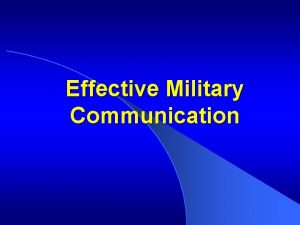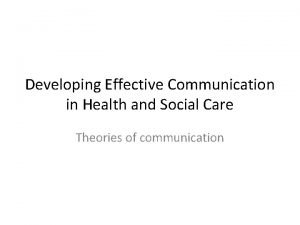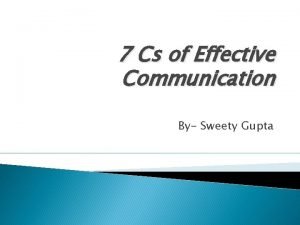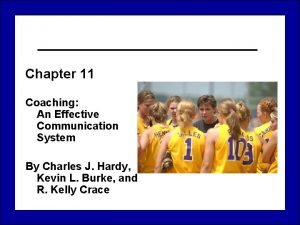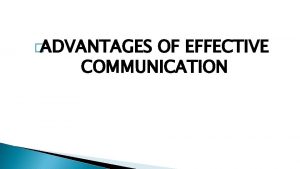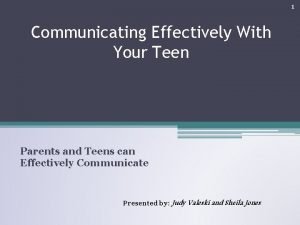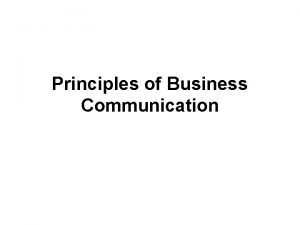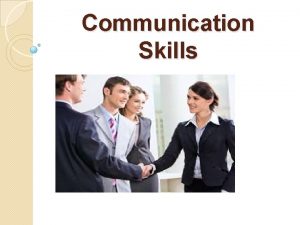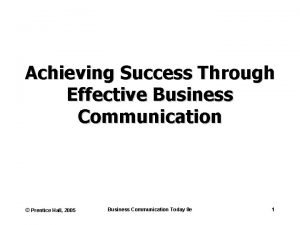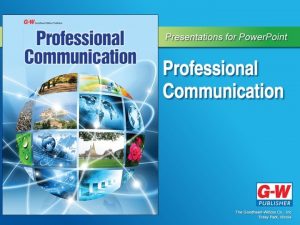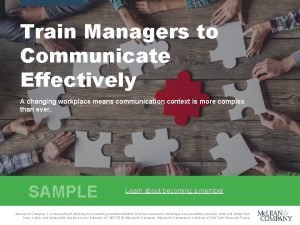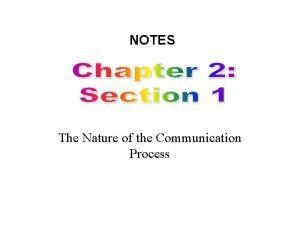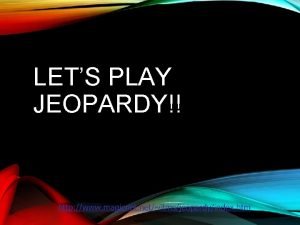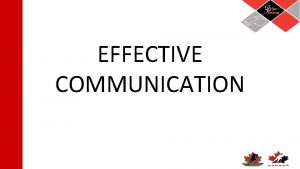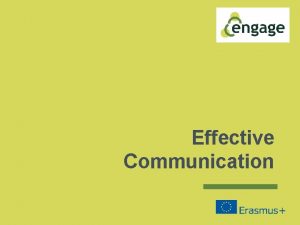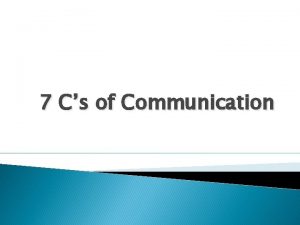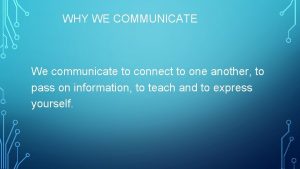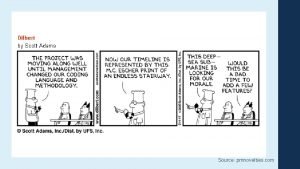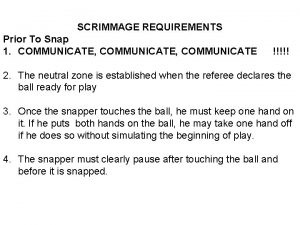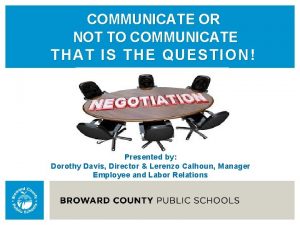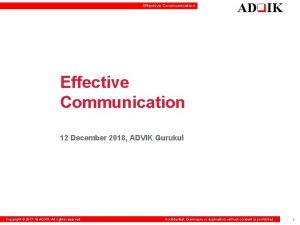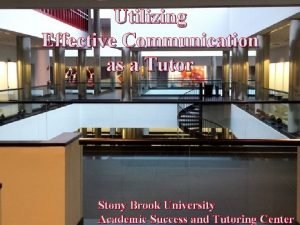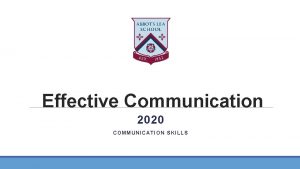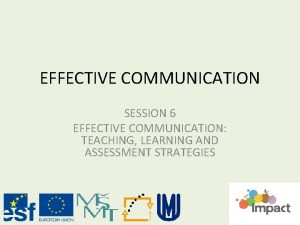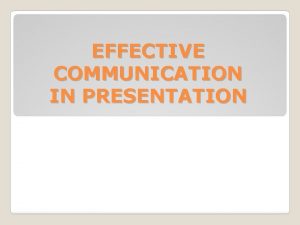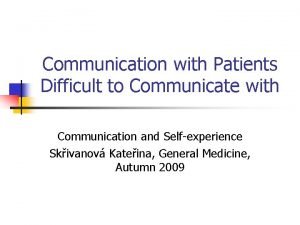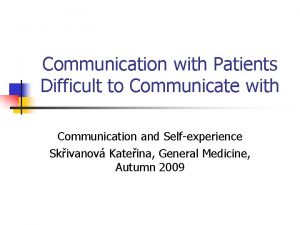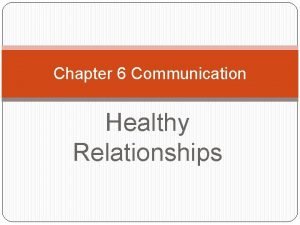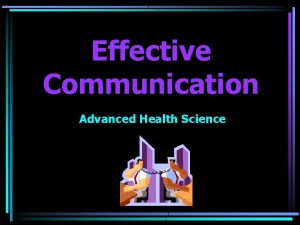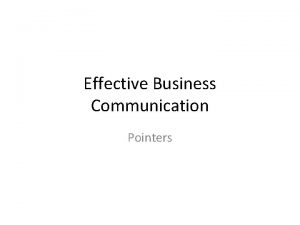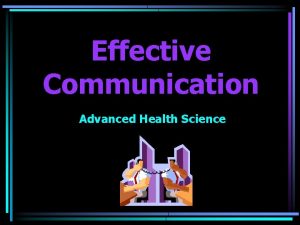Why do we communicate Developing Effective Communication in














































- Slides: 46

Why do we communicate? ‘Developing Effective Communication in Health and Social Care

What will we learn? Understanding that their our different communication and language needs Investigating barriers to communication and different environments Demonstrating how can service users be assisted by effective communication. Understanding different types of communication Researching the communication cycle Be able to show evidence of your own communication skills

Todays lesson objectives l l All of us will be able to identify key aspects of our first unit on effective communication Most of us will be able to define what the two main types of communication are MOST of us will be able to describe at least three steps to effective verbal communication SOME of us will start investigating the importance of non verbal communication?

TODAYS KEY WORD…. INTERPERSONAL “Interpersonal skills are the techniques people use in order to communicate and maintain effective relationships”

We communicate: l l l l To make relationships To maintain those relationships To pass information To meet our needs To develop and maintain our self concept To work effectively For our happiness

So what’s different about communicating in care settings? l l We need to make professional relationships We need to obtain and share information about service users, sometimes by using special methods We often need to put our own needs to one side and focus on meeting the service users needs But our communication at work still affects our self concept and happiness.

ALWAYS REMEMBER PLEASE…. Every example you give in your work MUST be related to a HEALTH AND SOCIAL CARE SETTING. Communication is important in all careers but we are specifically interested in health and social care environments!! Recap* what are some H&SC and Early year Settings?

Youth club Children's centres CARE HOMES Health and Social Care Services…. Social workers Physiotherapy Dentists Hospitalsdoctors/ nurses Schoolsteachers Counsellors Counselling Nurseries Residential Homes

Contexts of communication in health and social care l Health and social care professionals have to develop effective communication skills in order to work with the different/diverse range of people who use and work within care services because of multi -cultural nature in the British society. l The two contexts, or types of circumstances, in which communication and interaction occur are one-to-one and group contexts. Ms. Nichols 2011

One-to-one communication § One-to-one communication occurs when one person speaks with or writes to another individual. This happens when a care professional meets with a person who has health worries or personal concerns, such as during a doctor–patient appointment for example. Effective communication is an important feature of care practice Ms. Nichols 2011 .

One-to-one communication Cont’d. l Lots of one-to-one communication also occurs when care professionals meet with and talk to each other or with the partners, relatives or friends of people receiving care. l Communication in one-to-one situations is most effective when both parties are relaxed and are able to take turns at talking and listening. l Effective communicators are good at: l beginning the one-to-one interaction with a friendly, relaxed greeting focusing on the goal or ‘business’ of the interaction and ending the interaction in a supportive, positive way. Ms. Nichols 2011

Group communication l Group communication follows slightly different ‘rules’ to communication in one-to-one situations. There is often more going on in a group, with a number of different people trying to speak, get their point across and their voice heard. l Turn-taking can be more complicated; relationships and power issues between group members can also be more complex than in one-to-one contexts. l l Ms. Nichols 2011

Welcoming people Problem solving Oral com municat Calming people who are experiencing strong emotions ion Establishing professional relationships Asking for information Explaining issues, policies and procedures Clarifying issues Providing emotional support Building an understanding of another person’s life Carrying out interviews and assessments Exchanging ideas/learning new. Building a sense of trust ideas K. Nichols 2013

Problems with. . . . K. Nichols 2013

Technological Aids/ Email Phone Text Hearing Aid M

Special Methods Braille Sign Language Makaton

There are TWO main types of communication styles that we need to consider…. VERBAL COMMUNICATION NON-VERBAL COMMUNICATION

IN GROUPS OF THREE PLEASE PICK FOUR OF THE HEALTH AND SOCIAL CARE SERVICES AND ANSWER THE FOLLOWING QUESTIONS. 1) WHY IS COMMUNICATION IMPORTANT WITHIN THAT ENVIRONMENT 2) WHO ARE WE LIKELY TO BE COMMUNICATING WITH IF WE WORKED IN THAT ENVIRONMENT EXTENSION If you finish that can you go on to start thinking about three examples of what EFFECTIVE communication actually is?

ACTIVITY THINK BACK TO YOUR OWN COMMUNICATION EXPERIENCES In groups of 4 I would like you to share your experiences of verbal communication. Think of both positive and negative experiences and brainstorm these on your paper. Then come to a UNANIMOUS DECISION about what effective VERBAL communication means to your group

SO WHAT IS EFFECTIVE VERBAL COMMUNICATION? 1) Speaking clearly 2) Knowing your audience 3) Using appropriate language 4) Understanding the message you are trying to convey 5) Speaking at the correct pace

Verbal Skills l l Tone/Pace Listening Not talking, concentrating on what is said l Open questions A question that can’t be answered with yes or no. l Closed questions A question that can be answered with yes or no l Paraphrasing Repeating back what the person has said using their own words/phrases l Clarifying/Summarising Repeating back what the person has said in a different way

DIFFERENT SERVICE USERS WILL HAVE A PREFERRED WAY OF BEING COMMUNICATED WITH AND AS THE PROFESSIONAL IT WOULD BE OUR JOB TO RESPECT THAT IS WHY IT IS SO IMPORTANT FOR US TO LEARN IN THIS UNIT VARYING WAYS OF COMMUNICATION EFFECTIVELY……

Non-Verbal Skills l l l l Eye Contact Facial Expressions Hand movements Head movements Proximity Signs, symbols, pictures Posture Appearance

B A C YOU CAN’T HEAR ANYTHING BUT ARE THESE PICTURES COMMUNICATIN G ANYTHING? D E F

DISCUSSION POINT IS NON VERBAL COMMUNICATION AS IMPORTANT AS VERBAL COMMUNICATION? 5 MINUTES TO DISCUSS WITHIN YOUR GROUPS PLEASE BEFORE WE SHARE WITH THE CLASS

What have we achieved today? l l Can we ALL identify key aspects of our first unit on effective communication? Can ALL of us define what the two main types of communication are Can MOST of us describe at least three steps to effective verbal communication Has SOME of us started investigating the importance of non verbal communication?

LETS PLAY A GAME l Charades with a twist. l You have 3 minutes to write down as many things to act out that the other group must perform. Jobs, celebrities, movies, books, songs, pop culture! l

A PLENARY B COMPARE THESE TWO INTERVIEW PICTURES. ON YOUR POST IT PLEASE DECIDE WHICH ONE YOU THINK IS DEMONSTRATING THE MOST EFFECTIVE COMMUNICATION AND WHY. STICK ON THE FRONT OF YOUR BOOKS PLEASE FOR TOMORROWS LESSON.

What is communication and how does it happen? Definitions l Communication theory communication cycle(AO 3) l

Communication –some definitions ‘Communication is the ability to impart knowledge or information, or exchange thoughts , feelings or ideas by speech, writing, gestures and so on. ’ (Irving, J et al 1993 p 90)

What is communication ‘Communication involves a person passing information to another person by use of language and non verbal cues. ’ (Simpson H 1988 p 2)

Activity 1: l l l Choose a partner that you do not usually work with. Person whose first name is first in the alphabet is person A, partner becomes person B. Sit back to back. Person B needs a pen and paper. Person A must get person B to draw image (given). Person A can describe but not show the image to Person B cannot look round or speak.

Activity 2 l Person B now gets Person A to draw the image without showing the image to person A

The Communication Cycle There are many models to explain communication. Communication can be a l one way process l two way process or a l multi-way process. Today we will look at the first 2 models

One way process (first activity) Sender Message Receiver

Defining effective communication l l For communication to be effective it involves using skills and ‘engaging with the other person’ (Fisher 2005) If this happens the message sent will be the same as the message received and both people will know that.

K. Forster 2011

Two way process (second activity) Sender Message Feedback Receiver

This two way cycle involves: l l l l Sending a message Receiving what has been said Watching for non verbal messages Having emotional feelings Beginning to understand the other person Checking for barriers to communication Sending a message back to the other person

Environmental factors Meeting individual needs Ineffective interactions Sender Inappropriate use of skills Receiver P. I. E. S of both the sender & receiver Communication Cycle

Environmental Factors Noise – Background or sudden, external Heat – too hot or too cold Lighting – interrogation bright light or too dull and intimate! Space – too small room or large open area, lots of windows Interruptions – other people coming in the room or the interaction Room set up; positioning of sender and/or receiver, seating etc

Barriers or misuse of skills Not active listening – eg. Yawning, checking watch, gazing out window etc Emotional leakage – verbal and non-verbal messages do not match, true feelings show over professionalism Too many open/closed questions – like interrogation or not allowing for opinion Aggressive or intimidating body language Patronising tone, pace too fast or slow Lack of empathy or support Turn taking – no silences to think or time to respond

Meeting Needs of individuals Special Needs – specialised communication not used eg. Braille Cultural Differences – HSBC advert, something’s can be offensive Misunderstandings – no clarifying, misinterpretations, confusion etc. Appropriate language – formal, informal, street language, foreign language etc Not empathising – not reassuring, giving extra time, comforting distressed individual Poor previous experience - stereotyping

P. I. E. S of sender and receiver (P) Hungry, thirsty, in need of the toilet etc (E) Distressed, upset, anxious etc (S) Nervous or shy, low self esteem (I) Tired or bored Mind elsewhere, poor concentration Pain or injured, agitated or tense Depressed, withdrawn Crossing of boundaries of comfort Intimidated, unconfident etc

Summary We have: l Used types of communication l Used communication skills l Learnt theory of communication l Looked at factors that inhibit communication l Evaluated communication Covered all 5 topic areas of unit 2

l http: //www. wisconline. com/objects/View. Object. aspx? ID=I 2 P 40 1
 Hey hey bye bye
Hey hey bye bye Designing effective hrd programs
Designing effective hrd programs Developing an effective business model ppt
Developing an effective business model ppt Core strategy business model
Core strategy business model Developing effective study habits
Developing effective study habits Barringer ireland business model
Barringer ireland business model Steps in developing effective communications
Steps in developing effective communications Ineffictive
Ineffictive Developing effective research proposals
Developing effective research proposals Effective problem solving involves developing a
Effective problem solving involves developing a Hrd design
Hrd design Channel richness
Channel richness Effective communication cycle
Effective communication cycle Why communicate
Why communicate Dont ask
Dont ask Effective beginning
Effective beginning Summarizing is a powerful reading
Summarizing is a powerful reading Objectives of written communication
Objectives of written communication Seven steps of effective communication
Seven steps of effective communication The 5 inevitable laws of effective communication
The 5 inevitable laws of effective communication Environmental factors affecting communication
Environmental factors affecting communication Effective written communication
Effective written communication What is the importance of 7 c's of effective communication
What is the importance of 7 c's of effective communication Effectively communicate meaning
Effectively communicate meaning Importance of effective communication
Importance of effective communication Effectively communicate meaning
Effectively communicate meaning Ethics in communication
Ethics in communication Objective of effective listening
Objective of effective listening Competing messages communication barriers
Competing messages communication barriers Concrete in communication
Concrete in communication 5 cs of communication examples
5 cs of communication examples Factor affecting effective communication
Factor affecting effective communication Factors that affect communication
Factors that affect communication Military effective communication
Military effective communication Communication groups
Communication groups Good communication implies
Good communication implies Coaching in effective communication
Coaching in effective communication Advantage of effective communication
Advantage of effective communication Effective communication with your teenager
Effective communication with your teenager What are the principles of business communication
What are the principles of business communication Define communication
Define communication Communication skills quotes
Communication skills quotes Achieving success through effective business communication
Achieving success through effective business communication Introduction to professional communication
Introduction to professional communication Training managers to communicate effectively
Training managers to communicate effectively Communication is unavoidable.
Communication is unavoidable. Goal setting jeopardy
Goal setting jeopardy

